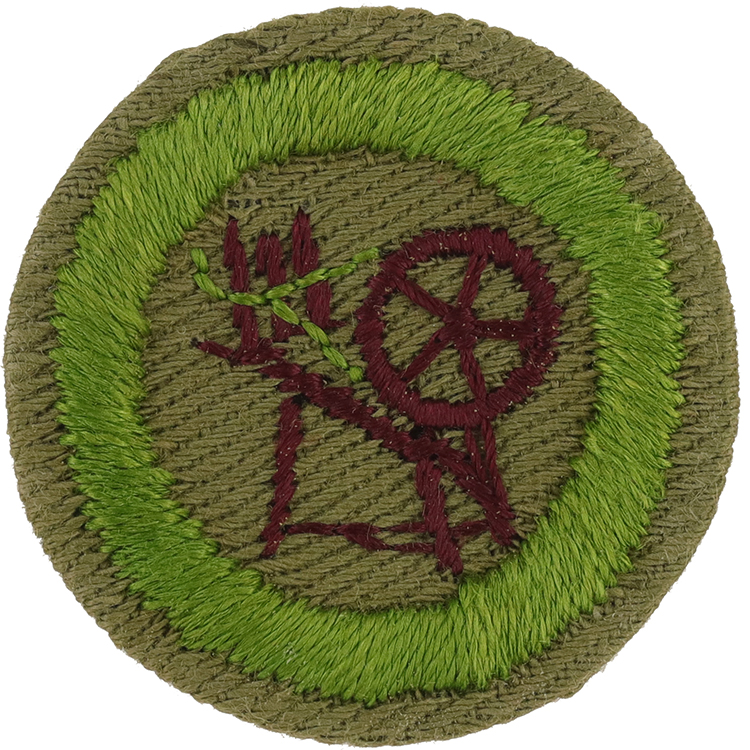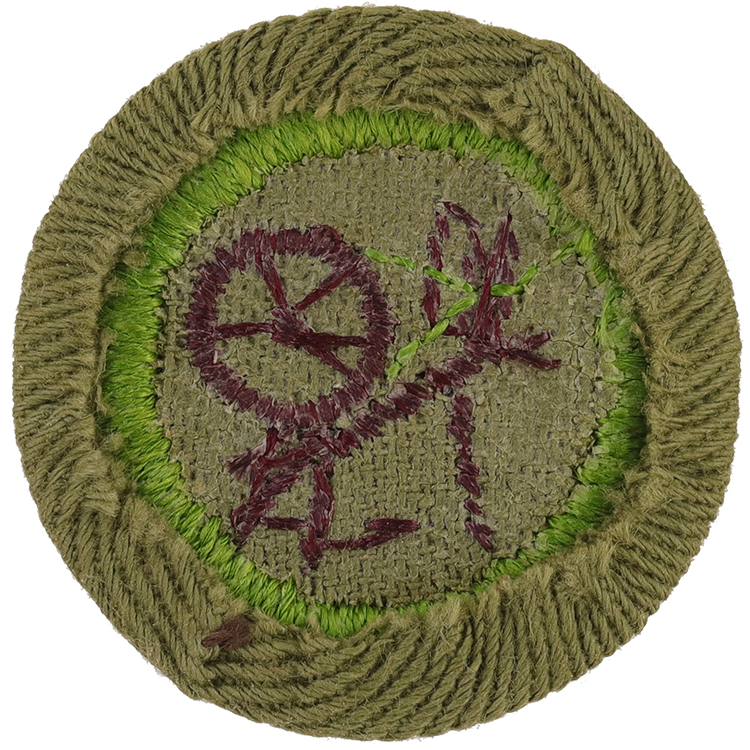
Fig. 1: Textis-E1-Front
- Cloth: Khaki right twill
- Embroidery: Cotton continuous

Fig. 2: Textis-E1-Reverse
- Back: Plain NO imprint with starch
Item Name: Textiles 1947 - 1960
Item ID: Textis-E1
Collector Rating: 1
Requirements May 1925 until June 1952
1. Identify a piece of woolen cloth.
Identify a piece of worsted cloth.
Identify a piece of cotton cloth.
Identify a piece of silk cloth.
Identify a piece of artificial silk cloth.
Submit a collection of samples.
State how he would distinguish each of the above.
2. (a) Know the physical properties (appearance) in the raw state of wool, worsted, cotton, silk and artificial silk.
(b) Know how yarns made from these fibers differ in their character, and state the means by which he would distinguish between them.
3. Distinguish between a woven fabric and a knitted fabric, and state which wears the better and why.
4. State how wool, cotton and silk are grown, and name the principal sources of supply of each.
5. Outline the different operations that would be used in converting some fiber into cloth. Name the machines that would be used and the kind of cloth that would be made. Report whether data for this test are gathered from visits to a factory or from texts.
6. Produce a sample and tell what properties a good piece of cotton or woolen wearing-apparel should possess.
7. State what the size numbers of yarns signify. Illustrate with at least two samples.
8. State which fibers are easier to dye and which are harder, and explain why in each case.
9. Name the two principal sources of dyestuffs.
Requirements June 1952 until June 1953
1. Submit samples of woolen, worsted, cotton, silk, rayon, nylon and glass cloth. Explain how you can tell one from the other, and state some of the most common uses of each.
2. (a) Know the physical properties (appearance) in the raw state of wool, worsted, cotton, silk and artificial silk; (b) know how yarns made from these fibers differ in their character, and state the means by which you would distinguish between them.
3. Distinguish between a woven fabric and a knitted fabric, and state which wears the better and why.
4. State how wool, cotton and silk are grown, and name the principal sources of supply of each.
5. Outline the different operations that would be used in converting some fiber into cloth. Name the machines that would be used and the kind of cloth that would be made. Report whether data for this test are gathered from visits to a factory or from texts.
6. Produce a sample and tell what properties a good piece of cotton or woolen wearing-apparel should possess.
7. State what the size numbers of yarns signify. Illustrate with at least two samples.
8. State which fibers are easier to dye and which are harder, and explain why in each case.
9. Name the two principal sources of dyestuffs.
Requirements June 1953 until June 1972
1. (a) Submit samples of the following yarn, thread, or fiber: cotton, wool, synthetic silk and linen. Discuss their sources, including the chief countries that produce them. (b) Tell how at least three of these fibers differ in character. Show one good method of testing fibers so as to recognize them.
2. Submit samples of woven fabrics containing cotton, wool, silk, linen, acetate, rayon, and nylon. Discuss the various qualities and common uses of each, including the garments you are wearing.
3. Submit two or more samples of knitted goods and discuss briefly the qualities of those as compared to woven fabrics.
4. Explain the principal operations used to manufacture any fiber into a fabric. Name the machines used and tell briefly what each machine does.
5. Discuss the types of dyes in general use and explain why some fabrics require different dyes than others. Discuss spun, stock yarn and piece dyeing. Discuss the qualities of a vat dye.
6. Do one of the following: (1) Visit a textile mill, clothing factory, or day plant and report fully to your counselor on this experience. (2) Waterproof a piece of fabric. (3) Weave an article on a simple loom that you have made yourself.
(b) Investigate and report on the career opportunities that are open to you in the textile or clothing manufacturing industries.
7. Explain ten of these textile terms: fiber, lament, yarn, short staple, ply yarn, burning test, fiber blends, warp, filling, pick, cloth count, pick glass, selvage, nap, gray goods, mercerized, color printing.
8. Show that you know something about the purchase and care of your own wearing apparel as follows: (a) Tell the meaning on labels of "reprocessed," "Sanforized," "preshrunk," and "water repellent." (b) Remove a grease spot from a piece of fabric by dry cleaning, using precautions against fire. (c) Give rules for proper cleaning and storing of your own garments. (d) Wash underwear and socks properly under camping conditions.



